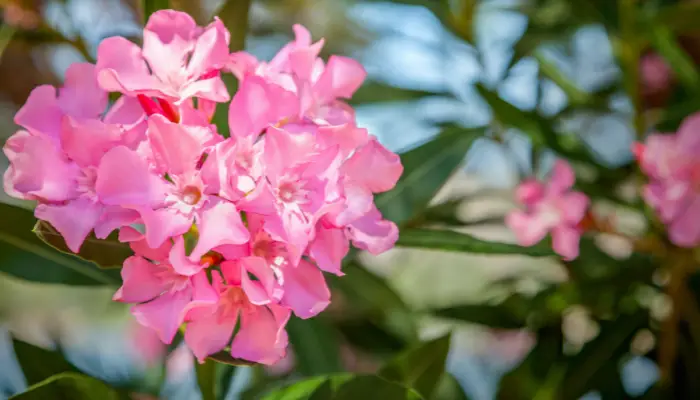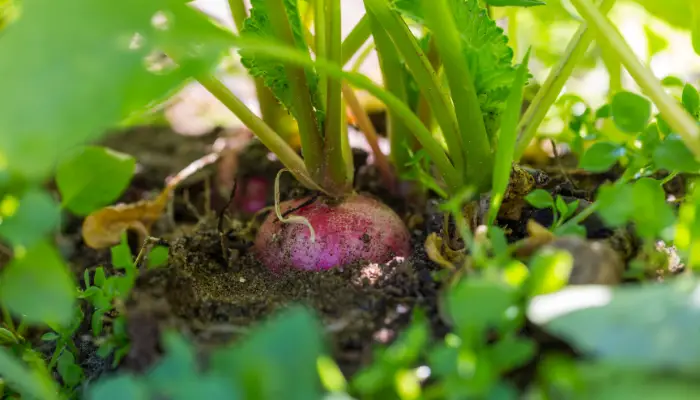What Part of Oleander is Poisonous: A Clear and Confident Answer
If you’re thinking about adding oleander to your garden, it’s important to know which parts of this popular evergreen shrub are poisonous. Oleander (Nerium oleander) contains cardiac glycosides in its roots, blooms, leaves, and stems, which can be toxic to humans and animals if ingested. These glycosides include oleandroside, nerioside, digitoxigenin, neriin, and oleandrin, which can cause a range of symptoms, from mild to severe.
Symptoms of oleander poisoning can include diarrhea, vomiting, nausea, dizziness, irregular heartbeat, weakness, and serious stomach pain. Ingesting oleander can also cause dilated eyes. If you suspect that you or someone you know has ingested oleander, it’s important to seek medical attention right away. In severe cases, oleander poisoning can be fatal.
It’s important to note that even handling oleander can be dangerous, as the toxins can be absorbed through the skin. For this reason, it’s important to wear gloves and protective clothing when pruning or handling oleander. By being aware of the potential dangers of oleander and taking the necessary precautions, you can enjoy this beautiful shrub in your garden without putting yourself or others at risk.

The Oleander Plant
If you have an oleander plant in your garden, it is important to be aware that all parts of the plant are toxic to humans and animals. This includes the leaves, flowers, twigs, stems, and sap. Oleander is so poisonous that even drinking water from a vase holding a bloom can cause a severe reaction.
The poisonous substances in oleander are called cardiac glycosides, which affect the heart and can cause irregular or slow heartbeat, low blood pressure, and weakness. Oleander poisoning can also affect other parts of the body, such as the eyes, ears, nose, mouth, and throat, causing blurred vision, vision disturbances, and halos around objects.
It is important to note that honey made from oleander flowers is also poisonous. Therefore, if you keep bees and have an oleander plant in your garden, it is best to remove it to prevent accidental poisoning.
In summary, if you have an oleander plant in your garden, it is important to be aware of its toxicity and take precautions to prevent accidental poisoning. Keep children and pets away from the plant, wear gloves when handling it, and avoid using any part of the plant for food or drink.
Poisonous Parts of Oleander

Oleander is a beautiful flowering shrub that can be found in many gardens and landscapes. However, it is important to know that all parts of the oleander plant are toxic and can cause severe illness or death if ingested.
The toxic substances found in oleander are cardiac glycosides, which can affect the heart and other organs. These substances are found in all parts of the plant, including the leaves, flowers, stems, and twigs. Even drinking water from a vase holding a bloom can cause a severe reaction.
Symptoms of oleander poisoning can affect many parts of the body. The National Institute of Health reports that symptoms can include:
- Irregular or slow heartbeat
- Low blood pressure
- Weakness
- Blurred vision
- Vision disturbances, including halos around objects
It is important to note that touching an oleander plant can also result in skin irritation, particularly if your skin comes into contact with the sap inside the plant. When working with your oleander plants, it is recommended to wear gardening gloves to keep your skin safe.
In conclusion, it is crucial to be aware of the poisonous nature of oleander and take necessary precautions when handling or growing this plant. If you suspect oleander poisoning, seek medical attention immediately.
Toxins in Oleander
Oleander plants are highly toxic and contain several toxins that can cause severe illness or even death. All parts of the oleander plant, including the leaves, flowers, twigs, and stems, contain toxic substances that can be harmful to humans and animals.
The toxins in oleander are cardiac glycosides, which are chemicals that affect the heart and can cause irregular heartbeats, low blood pressure, and weakness. These toxins can also cause gastrointestinal symptoms such as nausea, vomiting, and abdominal pain.
It’s important to note that oleander is so poisonous that even drinking water from a vase holding a bloom can cause a severe reaction. Therefore, it’s crucial to keep oleander plants away from children and pets.
Table 1 below shows the common toxins found in oleander plants:
| Toxins | Effects |
|---|---|
| Oleandrin | Affects the heart and can cause irregular heartbeats, low blood pressure, and weakness. |
| Neriine | Affects the heart and can cause irregular heartbeats, low blood pressure, and weakness. |
| Digitoxigenin | Affects the heart and can cause irregular heartbeats, low blood pressure, and weakness. |
If you suspect that you or someone else has ingested any part of an oleander plant, seek medical attention immediately. The symptoms of oleander poisoning can be severe and can lead to death if left untreated.
In conclusion, all parts of the oleander plant are toxic and can cause severe illness or death. The toxins in oleander are cardiac glycosides, which can affect the heart and cause irregular heartbeats, low blood pressure, and weakness. It’s essential to keep oleander plants away from children and pets and seek medical attention immediately if you suspect oleander poisoning.
Effects of Oleander Poisoning

Oleander is a highly toxic plant that can cause serious harm if ingested. All parts of the plant contain toxic compounds, including the flowers, leaves, stems, and twigs.
If you or someone you know has ingested any part of the oleander plant, it is important to seek medical attention immediately. Here are some of the potential effects of oleander poisoning:
Heart and Blood
Oleander poisoning can affect the heart and blood, causing symptoms such as:
- Irregular or slow heartbeat
- Low blood pressure
- Weakness
Eyes, Ears, Nose, Mouth, and Throat
Ingesting oleander can also affect the eyes, ears, nose, mouth, and throat, causing symptoms such as:
- Blurred vision
- Vision disturbances, including halos around objects
Stomach and Intestines
Oleander poisoning can also cause gastrointestinal symptoms, such as:
- Diarrhea
- Loss of appetite
- Nausea and vomiting
- Stomach pain
Nervous System
The nervous system can also be impacted by oleander poisoning. Symptoms may include:
- Confusion
- Sleepiness
- Shaking
- Disorientation
- Seizures
- Potential collapse
In severe cases, oleander poisoning can result in death, even with small amounts ingested. It is important to seek medical attention immediately if you suspect oleander poisoning.
Oleander Poisoning in Animals
Oleander is a highly toxic plant to both humans and animals. All parts of the plant contain toxic compounds called cardiac glycosides, which can cause serious health problems or even death if ingested.
Pets and livestock are also at risk of oleander poisoning. Dogs, cats, rabbits, horses, goats, and pigs are all susceptible to the toxic effects of oleander. Even tortoises can be affected.
Symptoms of oleander poisoning in animals include vomiting, diarrhea, abdominal pain, lethargy, abnormal heart rate, tremors, seizures, and even coma. If you suspect your pet or livestock has ingested oleander, it is important to seek immediate veterinary care.
Treatment for oleander poisoning in animals involves supportive care, including intravenous fluids, medications to control heart rate and blood pressure, and in severe cases, hospitalization. The prognosis for oleander poisoning depends on the amount of plant material ingested and how quickly treatment is sought.
To prevent oleander poisoning in animals, it is important to keep the plant out of reach. If you have oleander in your garden or landscape, make sure to supervise your pets and keep them away from the plant. If you suspect your pet has ingested oleander, do not induce vomiting and seek veterinary care immediately.
In conclusion, oleander is a beautiful but deadly plant for both humans and animals. It is important to be aware of the toxic effects of oleander and take precautions to prevent ingestion. If you suspect oleander poisoning, seek immediate veterinary care to ensure the best possible outcome.
Oleander Poisoning in Humans
Oleander (Nerium oleander) is a beautiful flowering shrub that can be found in many gardens, but it is important to know that it is also highly poisonous. All parts of the plant, including the leaves, flowers, and stems, contain toxic compounds known as cardiac glycosides. These compounds can cause serious harm to humans and animals if ingested.
Symptoms of oleander poisoning in humans can include diarrhea, dizziness, irregular heartbeat, nausea, serious stomach pain, vomiting, and weakness. In severe cases, oleander poisoning can lead to coma, seizures, and even death. It is important to seek medical attention immediately if you suspect that you or someone else has ingested oleander.
According to the Mount Sinai Health Library, there is no specific antidote for oleander poisoning. Treatment typically involves supportive care to manage symptoms and prevent complications. In some cases, activated charcoal or gastric lavage may be used to help remove the toxic compounds from the body.
It is important to note that oleander poisoning can also occur through skin contact with the plant or inhalation of smoke from burning oleander. If you are pruning or handling oleander, it is recommended that you wear gloves and protective clothing to avoid contact with the sap.
In conclusion, oleander is a highly poisonous plant that can cause serious harm to humans and animals if ingested or handled improperly. It is important to be aware of the potential dangers associated with oleander and to take appropriate precautions when handling or working around the plant.
Prevention and Treatment of Oleander Poisoning
If you suspect that you or someone you know has ingested any part of an oleander plant, it is crucial to seek medical attention immediately. Oleander poisoning can be fatal if left untreated.
Here are some steps you can take to prevent oleander poisoning:
- Do not plant oleander in areas where children or pets may come into contact with it.
- Wear gloves and protective clothing when handling oleander plants.
- Wash your hands thoroughly after handling oleander plants.
- Do not eat any part of the oleander plant.
If you suspect that you or someone you know has ingested any part of an oleander plant, here are some steps you can take:
- Call emergency services or poison control immediately.
- Do not induce vomiting unless instructed to do so by a medical professional.
- Provide as much information as possible about the suspected ingestion, including how much was ingested and when it occurred.
Treatment for oleander poisoning may include:
- Activated charcoal to prevent further absorption of the toxins.
- Intravenous fluids to help flush the toxins out of the body.
- Medications to treat symptoms such as irregular heartbeat or seizures.
- Hospitalization for observation and treatment.
Remember, prevention is key when it comes to oleander poisoning. Keep the plant away from children and pets, wear protective clothing when handling it, and seek medical attention immediately if ingestion is suspected.
Conclusion
In conclusion, all parts of the oleander plant are poisonous, but the highest concentration of toxins are found in the leaves and flowers. The plant contains cardiac glycosides, including oleandroside and nerioside, which can cause serious health problems if ingested.
Symptoms of oleander poisoning include diarrhea, dizziness, irregular heartbeat, nausea, serious stomach pain, vomiting, and weakness. If you suspect that someone has ingested oleander, it is important to seek medical attention immediately. Call the National Poison Control Center at 1-800-222-1222 for assistance.
It is also important to take precautions when handling oleander plants. Wear gloves and avoid contact with the sap, as it can cause skin irritation and other allergic reactions.
Overall, oleander is a beautiful plant that can add color and interest to your landscape, but it is important to be aware of its toxic properties and take appropriate measures to protect yourself and others from harm.
Frequently Asked Questions
What are the symptoms of oleander poisoning?
Oleander poisoning can cause a range of symptoms that affect different parts of the body. These symptoms can include stomach pain, nausea, vomiting, diarrhea, low blood pressure, irregular heartbeat, weakness and lethargy, depression, headache, tremors, dizziness and disorientation, sleepiness, fainting, and confusion. According to the National Institute of Health, getting medical help quickly increases the chance of full recovery.
How does oleander poisoning occur?
Oleander poisoning can occur if any part of the plant is ingested, including the flowers, leaves, stems, twigs, seeds, and nectar inside the flowers. Honey made from oleander flowers is also poisonous. Oleander poisoning can also occur if the plant is burned, as the smoke can contain toxic compounds.
What is the lethal dose of oleander?
The lethal dose of oleander depends on various factors, such as the age and weight of the person, the part of the plant ingested, and the method of ingestion. However, it is generally accepted that ingesting any part of the plant can be fatal, and even small amounts can cause serious health problems.
Can handling oleander cause poisoning?
Handling oleander can cause skin irritation and allergic reactions in some people, but it is generally not considered to be poisonous unless the plant is ingested or burned. However, it is still recommended to wear gloves and protective clothing when handling the plant to avoid skin irritation.
Is it safe to have oleander near children?
No, it is not safe to have oleander near children, as they may be tempted to eat the flowers or leaves, which can cause serious health problems. Oleander should be kept out of reach of children and pets, and any fallen leaves or flowers should be promptly removed from the ground.
What is the treatment for oleander poisoning?
The treatment for oleander poisoning depends on the severity of the symptoms and the amount of the plant ingested. In general, it is recommended to seek medical attention immediately if oleander poisoning is suspected. Treatment may include inducing vomiting, administering activated charcoal, and providing supportive care for symptoms such as low blood pressure and irregular heartbeat.








